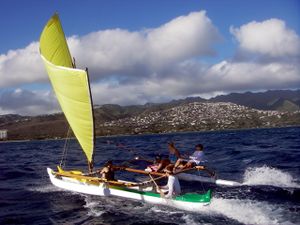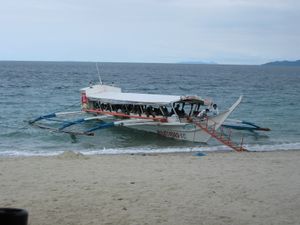Outrigger canoe
The outrigger canoe (Filipino and Indonesian: bangka; Māori: waka ama; Cook Islands Maori: vaka ama; Hawaiian: waʻa; Tahitian: vaʻa) is a type of canoe featuring one or more lateral support floats known as outriggers, which are fastened to one or both sides of the main hull. Smaller canoes often employ a single outrigger on the port side, while larger canoes may employ a single outrigger, double outrigger, or double hull configuration (see also catamaran). The sailing canoes are an important part of the Polynesian heritage and are raced and sailed in Hawaii and Tahiti.
Using an outrigger or double hull configuration greatly increases the stability of the canoe, but introduces much less hydrodynamic inefficiency than making a single hull canoe wider. Compared to other types of canoes, outrigger canoes can be quite fast, yet are also capable of being paddled and sailed in rougher water. This paddling technique, however, differs greatly from kayaking or rowing. The paddle, or blade, used by the paddler is single sided, with either a straight or a double-bend shaft. Despite the single paddle an experienced paddler will only paddle on one side, using a technique such as a J-stroke to maintain heading and stability.
The outrigger float is called the ama in many Polynesian and Micronesian languages. The spars connecting the ama to the main hull (or the two hulls in a double hull canoe) are called ʻiako in Hawaiian and kiato in Māori (with similar words in other Polynesian languages); in Micronesian languages, the term aka is used.
History
Outrigger canoes were originally developed by the Austronesian speaking peoples of the islands of Southeast Asia for sea travel, and were used to transport these peoples both eastward to Polynesia and New Zealand and westward across the Indian Ocean as far as Madagascar during the Austronesian migration period. Even today, it is mostly among the Austronesian groups (Malay, Micronesian, Melanesian and Polynesian peoples) that outrigger canoes are used.
Outrigger fishing canoes are also used among certain non-Austronesian groups, like the Sinhala in Sri Lanka, where they are known as oruwa,[1] as well as among some people groups in the Andaman and Nicobar Islands.[2] The ethnological significance of this spread has been studied by James Hornell.
When Magellan's ships first encountered the Chamorros of the Mariana Islands in 1521, Antonio Pigafetta recorded that the Chamorros' sailboats far surpassed Magellan's in speed and maneuverability.
The Polynesian Voyaging Society has two double hull sailing canoes, Hōkūleʻa and Hawaiʻiloa, and sails them between various islands in the Pacific using traditional Polynesian navigation methods without instruments.
The technology has persisted into the modern age. Outrigger canoes can be quite large fishing or transport vessels, and in the Philippines, outrigger canoes (called bangka, parao or balanghai) are often fitted with petrol engines. The links between seafaring and outrigger canoes in the Philippines extend through to political life, in which the smallest political unit in the country still called Barangay after the historical Balangai outrigger proas used in the original migrations of the first Austronesian peoples across the archipelago and beyond.
Modern sport use
Outrigger canoe racing has become a popular canoeing sport, with numerous clubs located around the world. Outrigger Canoe Racing is the State sport of Hawaii and an interscholastic high school sport. In Hawaii entire families participate in summer regattas with age groups from manini (children as young as 6 with an adult steersperson) and age 12 through age 60+.
Major races in Hawai'i include the Molokaʻi Hoe (43 mi/69 km men's race from the island of Molokaʻi to Oʻahu across the Kaiwi Channel), Na Wahine O Ke Kai (same race for women) and the Queen Liliʻuokalani Race held near Kona on the Island of Hawaiʻi.
Six person outrigger canoes (or OC6) are among the most common used for sport use; single person outrigger canoes (or OC1) are also very common. Two and four person outrigger canoes are also sometimes used, and two six person outrigger canoes are sometimes rigged together like a catamaran to form a twelve person double canoe.
Modern OC6 hulls and amas are commonly made from glass-reinforced plastic. However, some canoes are made of more traditional materials. In Ancient Hawaiʻi, canoes were carved from the trunks of very old koa trees. These canoes, although rare, are still very much in use today. The ʻiako are usually made of wood; the ʻiako-ama and ʻiako-hull connections are typically done with rope wrapped and tied in interlocking fashion to reduce the risk of the connection coming completely apart if the rope breaks.
Modern OC1 hulls and amas are commonly made from glass-reinforced plastic, carbon fiber reinforced plastic, and/or Kevlar to produce a strong but light canoe. OC1 are often made with rudders operated by foot pedals. More traditional designs do not have rudders. OC1 commonly use ʻiako made of aluminium, with a mechanism for quickly assembling and disassembling the canoe (snap buttons, large wing nuts, etc.).
See also
References
- ↑ Gerhard Kapitän, Records of native craft in Sri Lanka—I: The single outrigger fishing canoe oruwa—Part 2.2: Rowed, paddled and poled oru, International Journal of Nautical Archaeology, Vol. 18
- ↑ Irenäus Eibl-Eibesfeldt, Land of a Thousand Atolls: A Study of Marine Life in the Maldive and Nicobar Islands, World Publishing Co., Cleveland and New York, 1964.
Further reading
- Gary Dierking (2007) Building Outrigger Sailing Canoes, McGraw-Hill Professional. ISBN 978-0-07-148791-7
- Steve West (2006) 'Outrigger Canoeing - A Paddler's Guide', Batini Books, Kanuculture. ISBN 978-0-9586554-2-2
- Steve West (2006) 'Outrigger Canoeing - The Art and Skill of Steering', Batini Books, Kanuculture. ISBN 0-9586554-1-3
External links
| Outrigger canoes
]]- Polynesian Voyaging Society
- Takia Outrigger Canoe Club Fiji
- Northern California Outrigger Canoe Association
Hawai'i Association and Race Links
- Hawaiian Canoe Racing Association
- Queen Lili'uokalani Canoe Race (Kai 'Opua)
- Moloka'i Hoe
- Na Wahine O Ke Kai
- Japan Outrigger Canoe Network
- World of Boats (EISCA) Collection ~ Outrigger Canoes:
- Original Outrigger Canoe (Drua) in the Fiji Museum
- An Introduction to Outrigger Canoe Paddling
- Orchid Outriggers - Experience photo tours in handmade outrigger canoes on the central coast of California.
- An interactive for kids featuring a traditional outrigger canoe commissioned by the National Museum of Australia
- Dragon Boat and Outrigger Canoe website
- "The Longest Canoe Paddle in Modern History" Article about outrigger canoe trip to the Northwest Hawaiian Islands Hawai'i. Maui No Ka 'Oi Magazine Vol. 11, No. 1 (January 2007).
- "Canoes That Carve" Article about surfing outrigger canoes Hawai'i. Maui No Ka 'Oi Magazine Vol. 11, No. 3 (May 2007).
- "Master Strokes." Article about outrigger canoe club in Haleʻiwa, Hawai'i. Hana Hou! Vol. 10, No. 3 (June/July 2007).
- new hope outrigger - Complete online resource to the sport and history of outrigger canoeing.
| |||||
| ||||||||||||||||||||||||||||||||||||||||||||||||||||||||
de:Auslegerkanu fr:Pirogue à balancier it:Canoa polinesiana nl:Outrigger ja:アウトリガーカヌー pt:Outrigger sv:Utriggare to:pōpao



